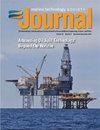Development and Validation of Embedded System Architecture for Shallow-Water Based H-AUV
IF 0.7
4区 工程技术
Q4 ENGINEERING, OCEAN
引用次数: 3
Abstract
Abstract Autonomous underwater vehicles (AUVs) have gained enormous popularity over the years and are employed extensively in various industries, including bio-research, subsea industries, and military applications. Most of the available commercial AUVs are very expensive and complex. This makes it unsuitable to be used for civilian applications. On the other hand, recent technological advancements have made it possible to have highly capable sensors at acceptable prices as an alternative to expensive commercial vehicles. In this paper, an embedded system-based multi-sensor hardware architecture for an H-configured AUV, called H-AUV, is designed and developed with low-cost, power-efficient, real-time controllers with a small footprint for data acquisition and sensors. These parameters play an important role for designing and developing energy-efficient autonomous vehicles. Significantly, auto navigation is a very important mechanism for AUVs, which includes auto heading control and depth keeping control techniques developed, deployed, and tested in the H-AUV. Additionally, the denoise filters such as moving average, exponential, and dynamic linear Kalman filter (KF) have been exercised and validated for heading and depth control of an H-AUV. It was found that the dynamic KF is very efficient and performs with 88% accuracy in the heading and depth control mechanisms. The KF is also found to perform with 98% accuracy for surface navigation of the H-AUV. Finally, an indigenous graphical user interface has been developed for data telemetry, command, and logging in autonomous and manual modes through wired and wireless communication. The proposed development and validation of an efficient and low-cost H-AUV shall support academic researchers for subsea applications.浅水H-AUV嵌入式系统架构的开发与验证
自主水下航行器(auv)近年来获得了极大的普及,并广泛应用于各个行业,包括生物研究、海底工业和军事应用。大多数可用的商用auv都非常昂贵和复杂。这使得它不适合用于民用。另一方面,最近的技术进步使得以可接受的价格拥有高性能传感器作为昂贵商用车辆的替代品成为可能。本文设计和开发了一种基于嵌入式系统的多传感器硬件架构,用于h配置的AUV,称为H-AUV,采用低成本,节能,实时控制器,用于数据采集和传感器的占地面积小。这些参数对于设计和开发节能自动驾驶汽车具有重要作用。自动导航是水下机器人的一个重要组成部分,包括自动航向控制和深度保持控制技术,已在H-AUV中开发、部署和测试。此外,还对移动平均、指数和动态线性卡尔曼滤波器(KF)等噪声滤波器在H-AUV航向和深度控制中的应用进行了验证。结果表明,动态KF在航向和深度控制机构中具有很高的效率,精度达到88%。KF也被发现在H-AUV的水面导航中具有98%的精度。最后,已经开发了一个本地图形用户界面,用于通过有线和无线通信在自主和手动模式下进行数据遥测、命令和登录。高效、低成本H-AUV的开发和验证将为水下应用的学术研究人员提供支持。
本文章由计算机程序翻译,如有差异,请以英文原文为准。
求助全文
约1分钟内获得全文
求助全文
来源期刊

Marine Technology Society Journal
工程技术-工程:大洋
CiteScore
1.70
自引率
0.00%
发文量
83
审稿时长
3 months
期刊介绍:
The Marine Technology Society Journal is the flagship publication of the Marine Technology Society. It publishes the highest caliber, peer-reviewed papers, six times a year, on subjects of interest to the society: marine technology, ocean science, marine policy, and education.
 求助内容:
求助内容: 应助结果提醒方式:
应助结果提醒方式:


